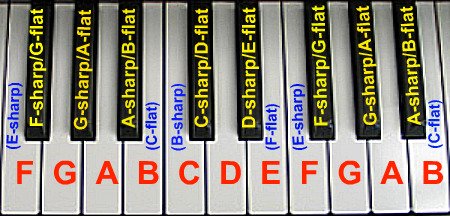The purpose of this website: helping you learn to play the piano. Building a strong foundation of piano-playing skills will lead to a lifetime of piano-playing joy.
Keys On A Piano
Learning the keys on a piano is not difficult. Study the following picture, memorizing the names of the notes, and then see if you can go to the piano and repeat the names as you play them.
Here are the notes on a piano, plain and simple:

Every white note can easily be found and recognized based upon its proximity to the black notes. Use the black note layout to find and learn the white notes. (See "Piano Notes Chart" for a few tricks to learning the white notes more effectively.)
Once you have the image of the black note layout in your mind, and the names of the white notes, the labeling of the black notes comes easily. Each black note is named according to the surrounding white notes. Whether the note is called "sharp" or "flat" depends upon which white note a composer wants to relate it to. The term "flat" means you step down (actually, a "half-step") from the note above. The term "Sharp" means you step up (a "half-step") from the note below.
Interestingly, even the white notes can be labeled with the term "flat" or "sharp". (See the blue labels in the picture.) This might seem a bit confusing at first, but just go with it until you've mastered all the scales and chords, and then it will begin to make more sense. (You can visit the "scales" page, or the "chords" page, for more on these important subjects.)
Left out of this picture is an even more obscure concept which you may encounter from time to time: the concept of "double-sharp" (notated with an "x") or "double-flat" (notated with two flat signs). For example, a "G" can also be labeled "F-double-sharp", or "A-double-flat". In a similar fashion, the note "D" may be labeled "C-double-sharp", or "E-double-flat". Cool, huh? (Again, do not worry about it... just be aware of it and accept it when it pops up from time to time.)
For a more complete understanding of how to build your piano-playing foundation, read
For the most direct, organized, and progressive path to learning to play the piano, start
the Piano Skills Foundation series of piano lessons.
(Advertisement)
How do the keys on a piano relate to notes on a page?
See "Piano Notes" for all 88 keys and and their corresponding written notes.
Enhance your piano keys recognition by learning familiar tunes
See "Free Piano Lessons" for ideas on how to learn the piano notes by actually playing tunes, learning scales & chords, and reading music.
Use your piano keys knowledge
See "Reading Music" for a plan to actually learn how to read music at the piano.
-click here for more about music theory-

If you want to see a blueprint for a successful piano journey...
read
"Piano Player... You"
A guide to building a solid and complete piano-playing foundation.
-Click here to learn more about this e-book-
If you would like a step-by-step guide to help you on your piano journey...
start working through
"The Piano Skills Foundation" piano lessons
-Click here to learn more about this piano course-
Return from "Keys On A Piano" to "True Piano Lessons"
Looking for some piano music?
I have found Sheet Music Plus to be a fantastic resource for piano books & other materials. And they have instant digital downloads for thousands of individual pieces.
3 Ways To Support This Website
If you enjoy using true-piano-lessons.com and would like to help support it:
1. Buy the ebook, "Piano Player... You"
2. Purchase "Piano Skills Foundation"
3.Donation
